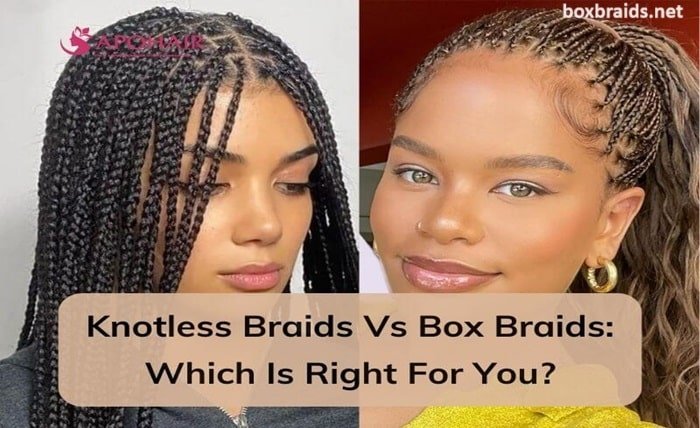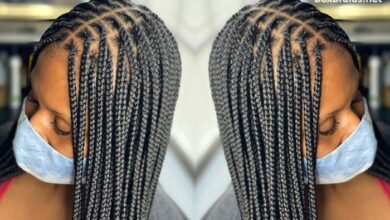Knotless vs. Box Braids: Exploring the Best Braiding Styles for You

Introduction
When it comes to choosing a protective hairstyle, both knotless and box braids are popular options that offer beauty and versatility. However, each style has its unique characteristics and benefits. This blog post delves into the differences between knotless vs. box braids, helping you make an informed decision based on your hair needs and lifestyle.
What Are Knotless Braids?
Knotless braids are a variation of traditional box braids but are considered to be more gentle on the hair and scalp. Unlike box braids, knotless braids start with your natural hair and gradually incorporate braiding hair, creating a seamless and knot-free base. This technique reduces tension and helps maintain hair health.
Box Braids
Box braids are a classic braiding style known for their box-like squared-off divisions. They start with a small knotted base where extensions are added right from the beginning. This style is revered for its durability and the ease of incorporating different lengths and volumes of hair.
Comparing Installation Techniques
The key difference in the installation process of knotless vs. box braids lies in how the hair is added. Knotless braids use a feed-in technique that gradually adds hair, making them less bulky and lighter on the scalp. Box braids, however, might cause more tension because of the immediate addition of extensions.
Tension and Comfort
One of the main advantages of knotless braids is the reduced tension and increased comfort. Since the braids are started without a knot, they put less stress on the scalp, making them ideal for those with sensitive scalps or thinner hair.
Durability and Longevity
Box braids are often praised for their durability. They can last anywhere from 6 to 8 weeks, depending on how well they are maintained. Knotless braids might require more maintenance due to their less secure starting method but can also last just as long with proper care.
Styling Versatility
Both knotless and box braids offer great styling versatility. However, knotless braids tend to look more natural and offer easier access to the scalp, making the style more versatile for different types of updos and ponytails.
Maintenance Requirements
Maintaining knotless and box braids requires regular moisturizing and cleansing routines. However, knotless braids may need more frequent touch-ups, especially at the roots, to maintain a neat appearance as they tend to loosen up faster than box braids.
Cost Considerations
Generally, knotless braids can be more expensive than box braids due to the longer installation time and the skill required to achieve the look. The cost can also vary based on the length and thickness of the braids you choose.
Which Is Better for Hair Health?
Knotless braids are often considered better for hair health as they reduce the risk of breakage and tension alopecia. They allow for easier scalp access to apply oils and treatments, thus promoting better scalp health.
Popular Trends and Inspirations
Both braiding styles have been popularized by celebrities and influencers, each bringing their own flair to these hairstyles. Social media platforms like Instagram and Pinterest are great sources for finding the latest trends and inspirations for both knotless and box braids.
Conclusion
Choosing between knotless vs. box braids ultimately depends on your personal preferences, hair type, and scalp sensitivity. Knotless braids offer a more natural look and less tension on the scalp, making them suitable for those looking for a comfortable style. On the other hand, box braids are excellent for those seeking a durable and low-maintenance option. Consider your lifestyle, budget, and hair needs when deciding which style to go for.
FAQs
Q1: Are knotless braids healthier than box braids?
A1: Yes, knotless braids are generally considered healthier as they cause less tension on the scalp, reducing the risk of hair breakage and tension alopecia.
Q2: Can both knotless and box braids be washed?
A2: Yes, both styles can be washed. However, it’s important to use a gentle cleansing method and avoid rigorous scrubbing to maintain the integrity of the braids.
Q3: How often should I redo my braids to maintain them?
A3: It’s recommended to redo your edges and touch up your braids every 4 to 6 weeks to keep them looking fresh and to prevent excessive tension on new hair growth.
Q4: Which style is more budget-friendly?
A4: Box braids are generally more budget-friendly due to the quicker installation process and less frequent need for touch-ups compared to knotless braids.
Q5: Can I switch from box braids to knotless braids easily?
A5: Yes, switching between the two styles is straightforward. Ensure your hair and scalp are healthy before transitioning to a new braiding style to prevent any hair damage.




